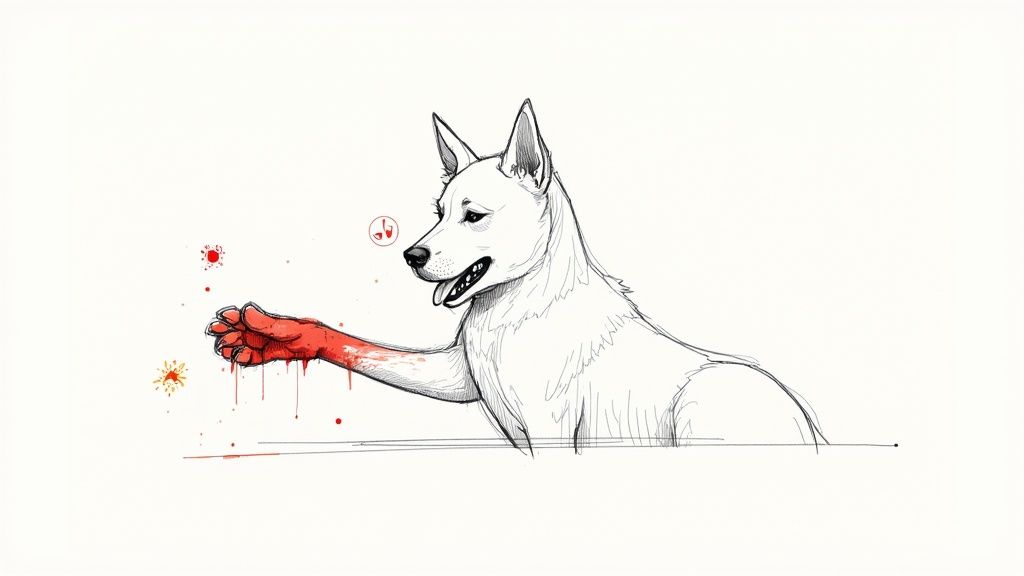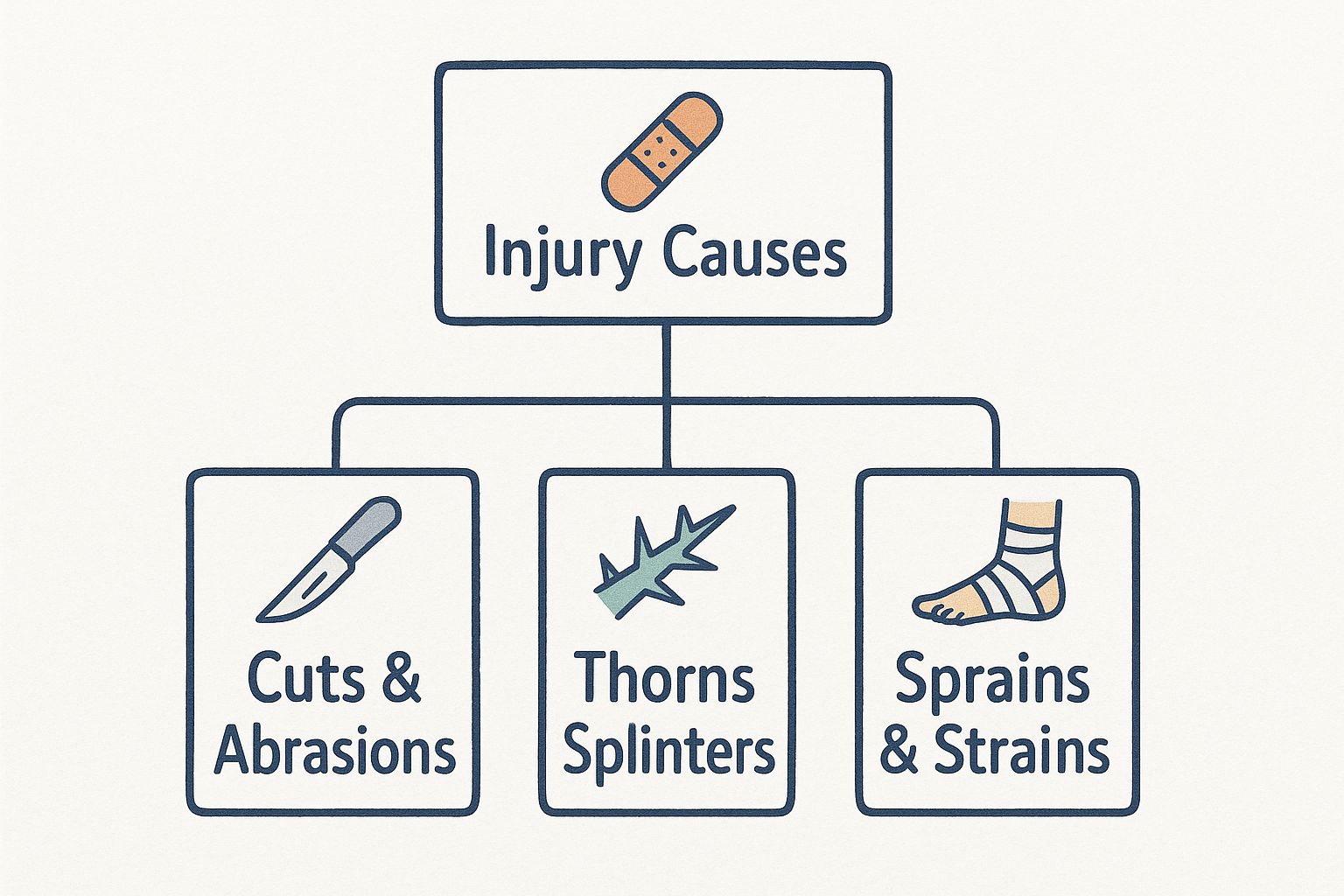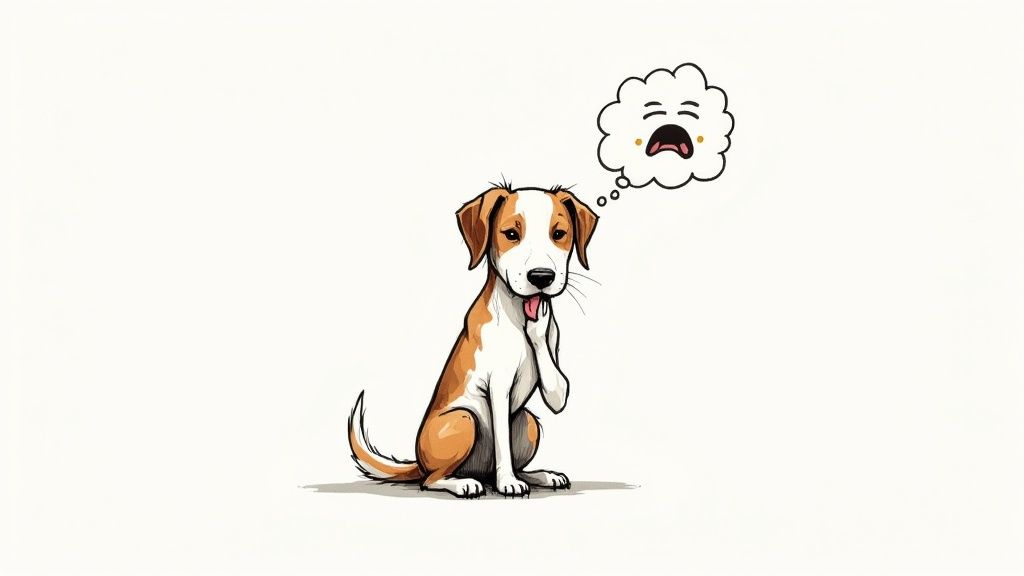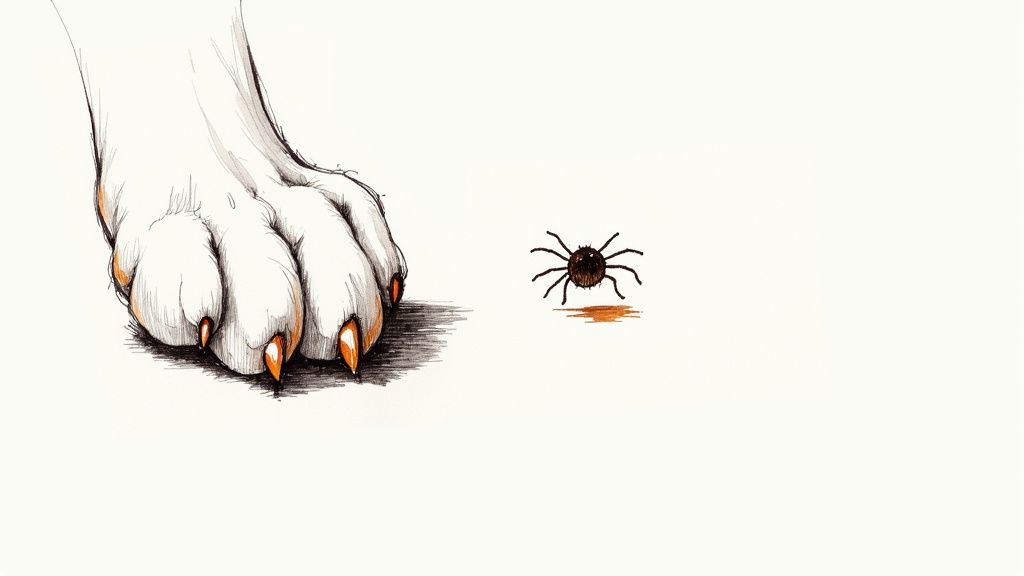It's completely normal for your dog to give their paws a quick clean-up slurp now and then. But if you find yourself constantly wondering, "why on earth is my dog licking his paw so much?", it’s usually their way of telling you something isn't right.
Think of it less as a quirky habit and more as a distress signal. Your dog could be trying to soothe anything from a tiny, hidden splinter to a nagging allergy or even feelings of stress.
Getting to the Bottom of Your Dog's Paw Licking

Let's dive into what's really going on. A quick lick here and there is just your dog’s version of wiping their feet after a muddy walk—totally natural. The worry starts when that licking becomes relentless.
When licking turns obsessive, it's your dog's most direct way of communicating discomfort. The source could be physical, like an itch caused by an allergy, or it might be emotional, born from boredom or anxiety. This guide will help you become a bit of a detective, piecing together the clues your dog is giving you through this very common, yet often misinterpreted, behaviour.
Is It Just Grooming or Something More?
The first, and most crucial, step is figuring out where the line is between normal grooming and a potential problem. A healthy self-clean is usually brief and covers all the paws.
Problematic licking, on the other hand, is often:
- Persistent: It goes on for ages, sometimes even waking them (and you!) up at night.
- Intense: You'll notice it’s more of a frantic, almost desperate licking rather than a gentle clean.
- Focused: The attention is almost always on one paw or a specific spot, like between their toes.
Here in the UK, vets recognise excessive paw licking as a clear symptom of various underlying health issues. While a bit of licking is fine, constant attention can quickly lead to sore, inflamed skin and even open wounds, turning a small issue into a much bigger one.
In fact, chronic skin problems, many of which involve paw licking, account for over 30% of all skin-related vet visits in the UK. This just goes to show how vital it is to get to the root of the problem. For a deeper dive into how vets approach this, you can check out these insights on dog paw licking.
Our aim here is to give you a clear roadmap to uncover the cause and, most importantly, find a solution that brings your dog some much-needed relief. To help you get a quick overview, let's break down the most common culprits.
Quick Guide to Paw Licking Causes
This table offers a snapshot of the most common reasons for paw licking, helping you quickly identify potential culprits.
| Potential Cause | Key Symptoms to Look For | Common UK Triggers |
|---|---|---|
| Allergies | Redness, swelling, itching, chewing, often affects other areas too. | Pollen (grasses, trees), dust mites, certain food proteins. |
| Injury | Limping, swelling, bleeding, a specific sore spot, reluctance to walk. | Thorns, glass shards, broken claws, insect stings. |
| Irritation | Red or discoloured fur, inflamed skin between the toes. | Road grit/salt in winter, harsh cleaning chemicals, wet paws. |
| Anxiety | Licking appears during stressful events, other compulsive behaviours. | Loud noises (fireworks), separation, changes in routine. |
By looking at your dog's specific symptoms and considering these common triggers, you can start to narrow down what might be causing the discomfort.
Uncovering Allergies and Skin Irritations
Imagine having an unbearable itch you can only soothe by scratching, but your only tool is your tongue. For many dogs, that’s exactly what an allergic reaction feels like. It's one of the most common reasons behind that persistent paw licking, and it makes perfect sense when you think about it. Their paws are in constant contact with the world, picking up all sorts of potential irritants along the way.
When your dog won't stop licking their paws, they're often just trying to get some relief from a maddening itch. The culprits usually fall into three main camps: environmental allergens, food sensitivities, or direct contact with an irritant. Each one leaves slightly different clues for you to follow.
The Most Common Allergy Triggers
Figuring out what's causing the problem is the first real step towards fixing it. An allergic reaction is simply the immune system going into overdrive against something it mistakenly sees as a threat, which leads to inflammation and that tell-tale itch.
Let's break down the primary types you're likely to encounter:
- Environmental Allergies: These are triggered by things in your dog’s everyday world. We're talking about pollens from grasses and trees, dust mites lurking in the carpet, or even mould spores in damp corners of the house. You might notice the licking gets much worse with the seasons, especially in spring and autumn.
- Food Allergies: While less common, a sensitivity to something in their diet can cause year-round itching. The usual suspects are common proteins like beef, chicken, dairy, and sometimes wheat.
- Contact Irritation: This is a direct reaction to something your dog's paws have physically touched. Think about pesticides on the lawn, road salt used during winter, or even the cleaning products you use on your floors.
A big clue that you're dealing with allergies isn't just the licking itself, but the state of the skin. Take a close look for any redness or swelling, especially between the toes. You might even notice a distinct 'yeasty' or musty smell, which often means a secondary infection has taken hold thanks to all that moisture.
Here in the UK, skin allergies are a major reason for excessive paw licking. In fact, veterinary data suggests that allergies affect roughly 10-15% of all dogs, and itchy paws are one of the first signs. With all our lovely green spaces full of pollens and grass seeds, it's no surprise that around 20-25% of dogs who see the vet for paw licking end up with an allergy management plan. You can read more from the PDSA's expert advice on the topic.
How to Spot the Difference
Putting on your detective hat can really help you and your vet narrow down the cause. Start by paying attention to when the licking happens. Does it flare up right after a walk in a grassy park? That’s a strong hint it could be an environmental allergy. Is it a constant, year-round problem that sometimes comes with an upset tummy? That might point towards a food allergy.
To help you distinguish between the different triggers, here’s a quick guide to what you might see.
Differentiating Between Common Allergy Types
| Allergy Type | Common UK Sources | Typical Signs Besides Paw Licking |
|---|---|---|
| Environmental | Grasses, tree pollens (birch, oak), dust mites, mould spores. | Seasonal itching (spring/autumn), ear infections, runny eyes, rubbing their face on furniture. |
| Food | Common proteins (beef, chicken, lamb), dairy, wheat, soy. | Year-round itching, digestive upset (diarrhoea, gas), chronic ear infections. |
| Contact | Lawn chemicals, de-icing salts, floor cleaners, certain fabrics. | Redness and irritation on paws, belly, or chin—areas that touch the ground. |
This table can help you start connecting the dots between your dog's symptoms and their potential triggers. Remember, building a strong skin barrier is also key to managing these issues. A great way to do this from the inside out is to understand how supplements can support your dog's skin health.

The infographic above outlines the main types of physical injuries that can also lead to paw licking. It’s a handy tool for separating allergy-driven behaviour from injury. If the licking started very suddenly after a trip outside and is laser-focused on just one paw, an injury is definitely a strong possibility.
Looking for Hidden Pain or Injury

While allergies often trigger a more generalised itchiness across several paws, intense licking focused on one specific spot is a huge clue. This tells you that pain is likely the real culprit. It’s not just a random itch; this is your dog's instinct to nurse a wound or soothe an ache. Think of it as their way of rubbing a sore muscle.
Sometimes the cause is right there in plain sight, like a cut after a run through thorny bushes or a swollen bee sting between their toes. But often, the source of the pain is hidden, requiring a bit of gentle detective work on your part.
A dog’s instinct to lick an injury is powerful and completely natural. They’re trying to clean the area and comfort themselves, but excessive licking can introduce bacteria or stop a wound from healing properly. That’s why your initial investigation is such a critical first step.
If your dog suddenly starts obsessing over one paw, especially after they’ve been outside, it’s time for a calm and careful inspection. This hands-on check can help you pinpoint the issue before it escalates into something more serious.
How to Safely Inspect Your Dog’s Paw
Your main goal here is to be gentle and reassuring. Pick a time when your dog is relaxed, not right after a zoomie session. Use plenty of praise and have some high-value treats ready to make it a positive experience. Rushing them will only add to their stress.
Here’s a simple step-by-step guide to check for hidden problems:
- Examine Top to Bottom: Start by just looking at the whole paw. Do you see any obvious cuts, scrapes, or swelling?
- Check Between the Toes: Gently spread each toe and peer into the crevices. This is a favourite hiding spot for thorns, pesky grass seeds, ticks, or even tiny shards of glass.
- Inspect the Paw Pads: Look closely at the pads for any punctures, blisters, or embedded objects. Feel for rough patches or anything that shouldn't be there.
- Feel for Heat or Swelling: Gently cup the paw in your hand. Does it feel warmer than their other paws? Heat is a classic sign of inflammation or an infection starting.
- Check Each Claw: Look at the nails one by one. Check for cracks, breaks, or anything caught up under the nail bed.
Common but Hidden Paw Injuries
Sometimes, the problem isn't a foreign object at all, but a less obvious injury. A minor sprain from landing awkwardly during a game of fetch can cause localised pain that triggers the licking.
Older dogs, in particular, might lick their paws to soothe the ache of arthritis in their wrist or ankle joints. They can't quite reach the sore joint itself, so they lick the closest accessible area—their paw. If you also notice stiffness or a reluctance to jump or play, it might be time to connect the dots. Finding the right support is crucial, and understanding the options for natural dog pain relief can offer much-needed comfort for these chronic conditions.
By investigating carefully, you can often find the source of the problem yourself. Catching a small splinter or a fractured claw early on can prevent a nasty infection and a much more stressful (and expensive) trip to the vet.
Digging into Behavioural Paw Licking

Sometimes, the answer to "why is my dog licking their paws?" has nothing to do with a physical problem. The root cause can be entirely emotional.
Think of it like a person who nervously bites their nails or taps their foot. For some dogs, licking their paws is a way to cope with feelings of anxiety, stress, or even just plain boredom. It’s a self-soothing behaviour. The repetitive action of licking actually releases endorphins, those natural feel-good chemicals, giving your dog a temporary sense of calm. This turns paw licking into a go-to coping strategy for managing overwhelming emotions.
Boredom vs. Anxiety: What's the Difference?
It’s crucial to figure out whether the licking is down to a lack of stimulation or something deeper. A bored dog will often start licking when there’s simply nothing better to do—maybe they’ve been left alone for a while without any toys or interaction. This kind of licking usually stops the moment something more interesting happens, like you picking up their lead for a walk.
Anxiety-driven licking, however, is a different beast. It's more compulsive and can happen even when you're right there with them. This behaviour is often tied to specific triggers that cause your dog real distress.
Common emotional triggers include:
- Separation Anxiety: The dog gets frantic when left alone, and the licking is their way of dealing with that panic.
- Fear of Loud Noises: Fireworks, thunderstorms, or even the hoover can set off a bout of anxious licking.
- Changes in Routine: A new baby, moving house, or even a change in your work schedule can throw your dog's world off-kilter and disrupt their sense of security.
Behavioural issues are a major reason for excessive paw licking here in the UK. Anxiety-related licking is especially common in dogs with separation anxiety, a condition that affects an estimated 14% of pets. In fact, studies show that around 30% of dogs undergoing behaviour therapy at specialised UK clinics show up with paw licking as a key symptom. For a deeper dive, you can read the full overview from The Kennel Club on dog licking behaviours.
Pinpointing the Emotional Triggers
Playing detective is key. Paying close attention to when the licking happens will give you big clues. If your dog suddenly develops the habit after you bring home a new kitten, stress is a likely culprit. If it only starts when you're grabbing your keys and coat to leave, you're probably looking at separation anxiety.
Once you identify these emotional triggers, you can start tackling the root of the problem. This often means using a mix of strategies: more enriching activities like puzzle toys, creating a solid and predictable routine, and doing confidence-building exercises to help your dog feel more secure.
For dogs who need a bit of extra help managing stress, options like calming treats for dogs can offer gentle, natural support. It's all about building a foundation for a calmer, happier companion.
Of course. Here is the rewritten section, designed to sound natural and human-written, as if from an experienced expert.
When to Call Your Vet About Paw Licking
It’s one thing to keep an eye on your dog at home, but some things just can't wait. Knowing when to switch from watching to calling the vet is key, because what starts as a minor irritation can spiral into a painful infection if it's left too long. Learning to spot the red flags takes the guesswork out of the equation and helps you get your dog the care they need, right when they need it.
Think of it this way: an occasional, quick lick is like your dog wiping their paws on the doormat. But non-stop, obsessive licking? That’s the fire alarm blaring. It’s a clear signal that something is seriously wrong and demands your immediate attention.
Critical Red Flags to Watch For
If you spot any of the following signs, it's time to pick up the phone and book a vet appointment. These symptoms are a strong indication that the problem is more than just a passing habit and needs a proper diagnosis.
Don't brush these warning signs aside:
- Relentless Licking: The licking is constant and intense, so much so that it’s interrupting your dog’s sleep or day-to-day activities.
- Visible Sores or Bleeding: You can actually see raw skin, open wounds, or blood on their paw or matted in the fur.
- Foul Odour: A musty, yeasty, or just plain unpleasant smell is a classic giveaway for a secondary bacterial or fungal infection.
- Limping or Favouring a Paw: Your dog is clearly trying not to put weight on that foot, which points to significant pain.
- Sudden and Intense Onset: If the licking started out of nowhere and is unusually severe, it could be an acute injury like an insect sting or something sharp stuck in their paw pad.
A word of caution: waiting can turn a small problem into a big one. For example, a tiny grass seed can work its way deeper into the tissue, potentially leading to surgery. Your best bet is always to act decisively as soon as you see something is wrong.
What to Expect at the Vet Visit
A little preparation can make the vet visit much less stressful. Your vet will almost certainly start with a thorough physical exam, getting a good look at the paws.
From there, they might suggest a few diagnostic tests. This could include a skin scrape to look for mites, cytology to check for yeast or bacteria under a microscope, or even allergy testing to get to the root of the trigger. It’s all part of a process to get an accurate diagnosis, which is the only way to create a treatment plan that will finally give your dog some real relief.
Practical Home Care for Healthy Paws
A little proactive care at home can make a world of difference in breaking the cycle of paw licking. By weaving a few simple habits into your dog's daily routine, you can get ahead of many common triggers before they start causing any real trouble.
One of the easiest things you can do? Wipe your dog's paws after every walk. Seriously, it’s that simple. Think of their paws as little sponges, soaking up all sorts of environmental allergens like pollen and grass, not to mention irritants like road salt or chemicals from treated lawns. A quick once-over with a damp cloth or a gentle wipe gets rid of that stuff before it has a chance to kick off an itchy reaction.
Building a Routine for Paw Wellness
Beyond a daily wipe-down, getting into the habit of doing regular paw checks is a game-changer. It only takes a few minutes a week, but it can help you spot a tiny issue before it blows up into a painful problem that sends your dog into a licking frenzy.
Here’s a simple routine to get you started:
- Weekly Paw Inspections: Gently take a look at each paw, spreading the toes to check in between and examining the pads. You're looking for anything out of the ordinary – small cuts, thorns, ticks, or any signs of redness or swelling. Catching these things early is half the battle.
- Keep Fur Trimmed: If you have a long-haired dog, keeping the fur between their paw pads neatly trimmed is a must. This simple trim stops the fur from getting matted and prevents nasty things like debris or ice balls from getting painfully trapped.
A healthy dog really does start from the inside out. Great nutrition plays a massive part in skin health, building a stronger skin barrier that makes them less vulnerable to whatever the world throws at them.
Redirecting Behaviour and Supporting Health
What if the licking is more of a habit, maybe from boredom or a bit of anxiety? In that case, redirection is your best friend. Instead of telling them off, which can sometimes make things worse, give them a better alternative.
Try using enrichment toys to keep their brain busy. Things like puzzle feeders or a really tough chew toy are brilliant for this. They give your dog a positive outlet for their energy and can break that compulsive licking habit. It’s also worth looking at their diet. Adding supplements with ingredients like omega-3 fatty acids can do wonders for their skin, helping to prevent the dryness and irritation that often starts the licking in the first place. It’s these small, consistent steps that add up to happy, healthy paws.
Your Paw Licking Questions Answered
We get it. When you’re dealing with a paw-licking problem, a million questions can race through your mind. Here, we've gathered some of the most common ones we hear from dog owners to give you some quick, clear answers and a bit of extra confidence.
Think of this as another layer of support, reinforcing the advice we've already covered and tackling those specific scenarios that so many of us face.
Can I Use Human Moisturiser on My Dog's Dry Paws?
That’s a definite no. It might seem like a quick fix, but human lotions can do more harm than good. Our skin has a totally different pH balance to a dog's, and many of our moisturisers contain chemicals and fragrances that are toxic if ingested.
And you know they’re going to lick it! That can lead to an upset stomach or even worse. Always stick to a balm or moisturiser specifically made for dogs. You can find these at your vet's clinic or a good pet shop – they're formulated to be both safe and effective.
Why Does My Dog Only Lick His Paws at Night?
This is a classic head-scratcher. If the licking ramps up when the lights go down, there are a few likely culprits. With fewer distractions around, your dog might finally be noticing an itch that’s been bothering them all day long.
It could also be a behavioural habit. When the house is quiet and everyone’s settled, boredom or anxiety can creep in, and licking becomes a self-soothing activity. It's also worth considering that allergens like dust mites are often lurking in their bedding. Noticing this pattern is a brilliant clue to share with your vet.
Key Insight: It's true that some breeds are just more prone to conditions that trigger paw licking, especially skin allergies (atopic dermatitis). We often see this in West Highland White Terriers, French Bulldogs, Labradors, and Boxers. But remember, any dog can develop these problems, so every owner needs to stay vigilant.
Pinpointing the trigger is always the first, most crucial step towards finding a solution that brings your dog lasting relief.
At Tipaw, we’re committed to helping dogs live their best lives—happy, healthy, and comfortable. Our vet-approved, natural supplements are crafted to support your dog’s well-being from the inside out, tackling everything from itchy skin to joint discomfort. Explore our range of effective solutions you can trust at https://www.store-tipaw.com.





